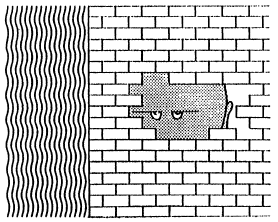
This section describes some of the physical methods which architects, developers and builders can employ to reduce noise impacts. There are four major actions which can be taken to improve noise compatibility for any type of land use or activity. These are site planning, architectural design, construction methods, and barrier construction.
Acoustical site design uses the arrangement of buildings on a tract of land to minimize noise impacts by capitalizing on the site’s natural shape and contours. Open space, nonresidential land uses, and barrier buildings can be arranged to shield residential areas or other noise sensitive activities from noise, and residences can be oriented away from noise.
Acoustical architectural design incorporates noise reducing concepts in the details of individual buildings. The areas of architectural concern include building height, room arrangement, window placement, and balcony and courtyard design.
Acoustical construction involves the use of building materials and techniques to reduce noise transmission through walls, windows, doors, ceilings, and floors. This area includes many of the new and traditional “soundproofing” concepts.
Noise barriers can be erected between noise sources and noise-sensitive areas. Barrier types include berms made of sloping mounds of earth, walls and fences constructed of a variety of materials, thick plantings of trees and shrubs, and combinations of these materials.
These physical techniques vary widely in their noise reduction characteristics, their costs, and especially, in their applicability to specific locations and conditions. This section is not designed to provide complete criteria for selecting a solution to particular noise problems and is not intended as a substitute for acoustical design. Rather, its purpose is to illustrate the wide range of possible alternatives which could be considered in the architectural and engineering planning process. Knowledgeable municipal officials can provide valuable assistance to designers, developers, and builders who may not be familiar with sound attenuation techniques that are most applicable locally.
The arrangement of buildings on a site can be used to minimize noise impacts. If incompatible land uses already exist, or if a noise sensitive activity is planned, acoustical site planning often provides a successful technique for noise impact reduction.
Many site planning techniques can be employed to shield a residential development from noise. These can include:
The implementation of many of the above site planning techniques can be combined through the use of cluster and planned unit development techniques.
Distance: Noise can be effectively reduced by increasing the distance between a residential building and a highway. Distance itself reduces sound: doubling the distance from a noise source can reduce its intensity. Distance itself reduces sound: doubling the distance from a noise source can reduce its intensity by as much as 6 dBA. In the case of high rise buildings, distance may be the only means, besides acoustical design and construction, of reducing noise impacts. This is because it is nearly impossible to provide physical shielding for the higher stories from adjacent noise. (See Figure 4.1.)
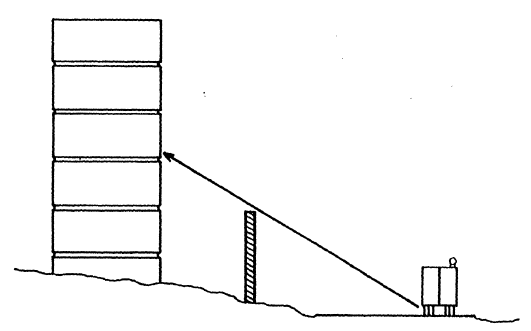
Noise Compatible Land Uses as Buffers: Noise protection can be achieved by locating noise-compatible land uses between the highway and residential units. Whenever possible, compatible uses should be nearest the noise source. Figure 4.2 which follows shows a proposed parking garage along two sides of a development in Boston. Both the Fitzgerald Expressway and the entrance to the Callahan Tunnel which are shown on the site plan are major and noisy traffic routes. In addition to protecting the residential development from the noise and dirt of highway traffic, the parking garage provides needed facilities for the residents
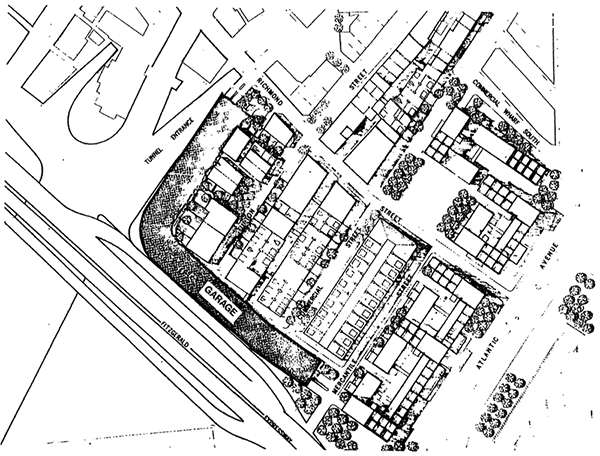
Figure 4.3 provides another example of locating noise-compatible uses near a highway (West Street) in Springfield, Massachusetts. From the plan, one can see that parking spaces, ends of buildings, and a baseball diamond are near the highway.
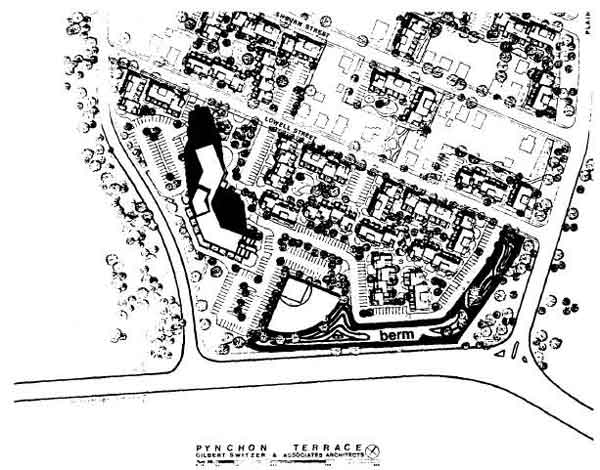
Buildings as Noise Shields: Additional noise protection can be achieved by arranging the site plan to use buildings as noise barriers. A long building, or a row of buildings parallel to a highway can shield other more distant structures or open areas from noise. One study shows that a two-story building can reduce noise levels on the side of the building away from the noise source by about 13dBA.1
If the use of the barrier building is sensitive to highway noise, the building can be soundproofed. This technique was used in a housing project under construction in England where a 3,900 foot long, 18 foot wide and 45-70 foot high wall (depending on the terrain) serves as both residence and a sound shield.2
The wall/building will contain 387 apartments in which the kitchens and bathrooms are placed towards the noise, and the bedrooms and living rooms face away from the highway. The wall facing the highway will be soundproofed and windows, when they exist, are sealed. Substantial noise reductions are expected.
Orientation: The orientation of buildings or activities on a site affects the impact of noise, and the building or activity area may be oriented in such a way as to reduce this impact.
Noise impacts can be severe for rooms facing the roadway since they are closest to the noise source. The noise impact may also be great for rooms perpendicular to the roadway because a) the noise pattern can be more annoying in perpendicular rooms and b) windows on perpendicular walls do not reduce noise as effectively as those on parallel walls because of the angle of the sound. Road noise can be more annoying in perpendicular rooms because it is more extreme when it suddenly comes in and out of earshot as the traffic passes around the side of the building, rather than rising and falling in a continuous sound, as it would if the room were parallel to passing vehicles.
Whether the noise impact is greater on the perpendicular or the parallel wall will depend on the specific individual conditions. Once the most severely impacted wall or walls are determined, noise impacts may be minimized by reducing or eliminating windows from these walls.
Buildings can also be oriented on a site in such a way as to exploit the site’s natural features. With reference to noise, natural topography can be exploited and buildings placed in low noise pockets if they exist. If no natural noise pockets exist, it is possible to create them by excavating pockets for buildings and piling up earth mounds between them and the noise. Such a structure would obstruct the sound paths and reduce the noise impacts on the residences.
Cluster and Planned Unit Development: A cluster subdivision is one in which the densities prescribed by the zoning ordinance are adhered to but instead of applying to each individual parcel, they are aggregated over the entire site, and the land is developed as a single entity. A planned unit development, or P.U.D., is similar but changes in land use are included, such as apartments and commercial facilities in what would otherwise be a single-family district. Examples of grid, cluster and P.U.D. subdivisions follow in Figures 4.4, 4.5, and 4.6.
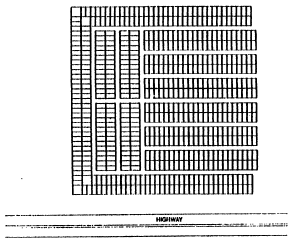
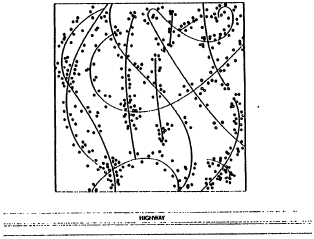
From Figure 4.4 it can be seen how the conventional grid subdivision affords no noise protection from the adjacent highway. The first row of houses bears the full impact of the noise. In contrast, the cluster and P.U.D. techniques enable commercial uses and open space respectively to serve as noise buffers. Examples of this are shown in Figures 4.6 and 4.7.
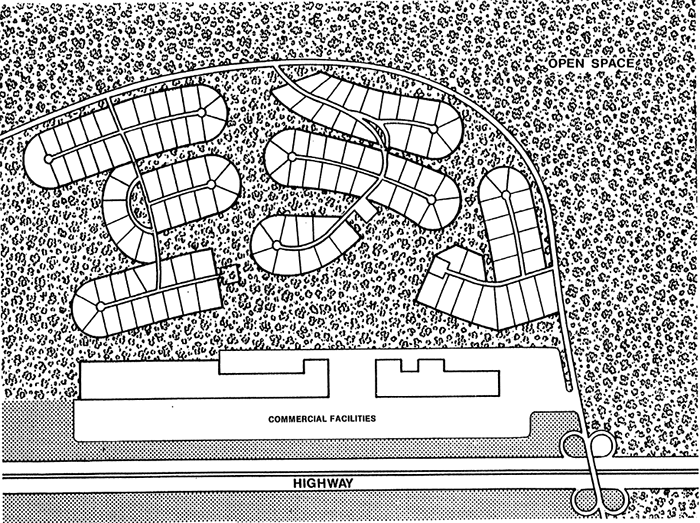
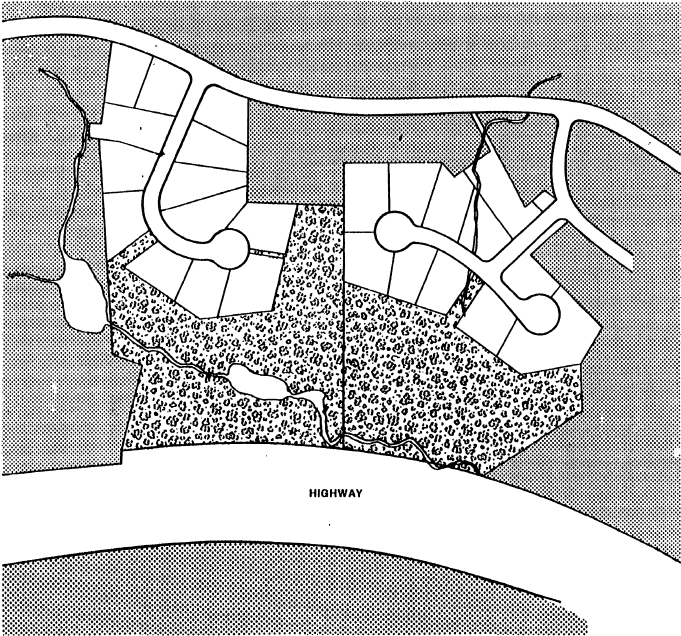
A word of caution is necessary: in a cluster development, the required open space can be located near the highway to minimize noise to the residences. However, many recreation uses are noise sensitive, and when one takes advantage of the flexibility of cluster development to minimize noise, care must be taken not to use all of the available open space in buffer strips, thus depriving the development of a significant open space area. Where high noise levels exist, a combination of buffer strips and other techniques (such as berms and acoustical sound proofing) can be employed.
The flexibility of the cluster and planned unit development techniques allows many of the above site planning techniques to be realized and effective noise reduction achieved.
Noise can be controlled in a building with proper architectural design. By giving attention to acoustical considerations in the planning of room arrangement, placement of windows, building height, balconies, and courtyards, the architect may achieve significant noise impact reduction, without the need for costly acoustical construction.
Room Arrangement: Noise impacts can be substantially reduced by separating more noise sensitive rooms from less noise sensitive rooms; and placing the former in the part of the building which is furthest away from the noise source. The less sensitive rooms should then be placed closest to the noise source where they can act as noise buffers for the more sensitive rooms.
Whether or not a room is noise sensitive depends on its use. Bedrooms, living rooms, and dining rooms are usually noise sensitive, while kitchens, bathrooms, and playrooms are less so. Figure 4.8 shows a layout designed to reduce the impact of highway noise. This technique was used extensively in England in a 100 acre residential development adjacent to a planned expressway.3 Kitchens and bathrooms were placed on the expressway side of the building, and bedrooms and living rooms were placed on the shielded side. In addition, the wall facing the expressway is sound insulated.
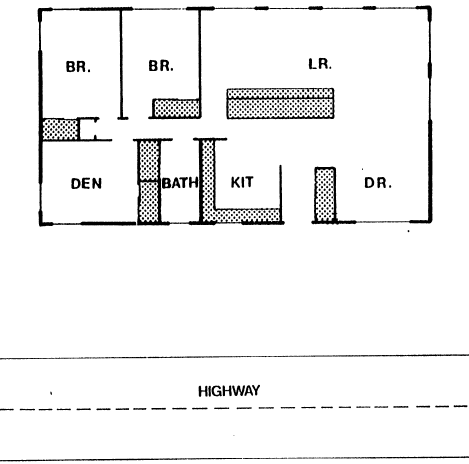
Solid Walls: Noise can be reduced by eliminating windows and other openings from the walls of a building close to noise sources. The solid wall can then have the effect of a sound barrier for the rest of the building. As previously discussed in Figure 4.1, walls directly adjacent, and those perpendicular to the noise source can be the most severely impacted. When a solid wall is impractical, illegal, or highly undesirable; the same effect can be achieved by reducing window size and sealing windows airtight. This technique is used in the housing project described above.4
One Story Houses: In cases where either the house or the highway is slightly recessed or a barrier has been placed in the sound path, the noise impact may be further reduced if the house has only one story5 (See Figure 4.9). If the single-story design is inefficient, the split-level design may be effective. In any case the path of the sound waves should be assessed before the building design is drawn.
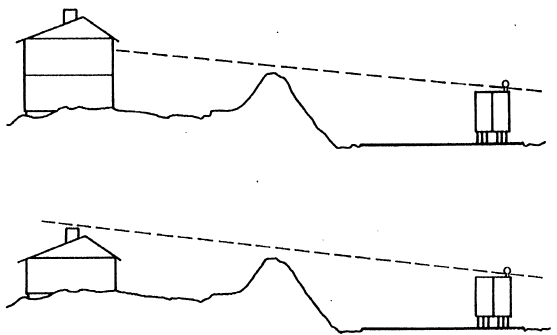
Balconies: If balconies are desired they should be given acoustical consideration. The standard jutting balcony, facing the road, may reflect traffic noise directly into the interior of the building in the manner illustrated in Figure 4.10. In addition to reflecting noise into the building, the balcony may be rendered unusable due to the high noise levels. This problem is particularly applicable to high rise apartment buildings where balconies are common. If balconies are desired, the architect may avoid unpleasant noise impacts by placing them on the shielded side of the buildings.
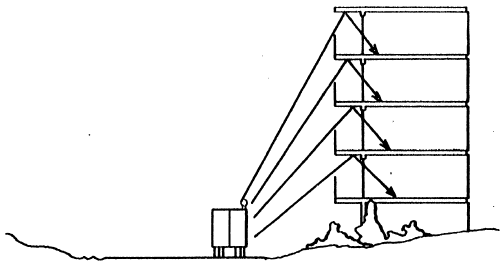
Courtyards: Proper architectural design may also provide for noise reduction in an area outside of the building. The court garden and patio houses can provide outdoor acoustical privacy. (See Figure 4.11). Schools, rest homes, hotels, and multi-family apartment dwellings can also have exterior spaces with reduced noise by means of court yards.
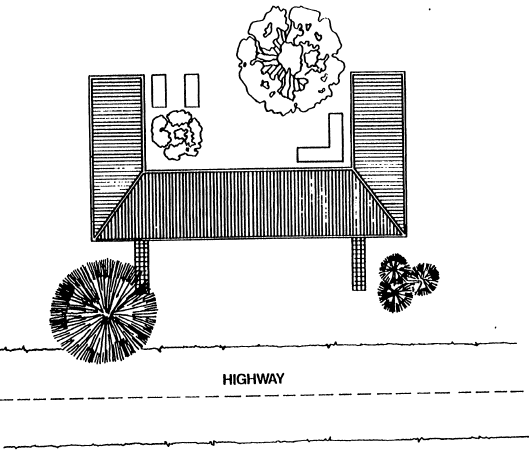
Noise can be intercepted as it passes through the walls, floors, windows, ceilings, and doors of a building. Examples of noise reducing materials and construction techniques are described in the pages that follow.
To compare the insulation performance of alternative constructions, the Sound Transmission Class (STC) is used as a measure of a material’s ability to reduce sound. Sound Transmission Class is equal to the number of decibels a sound is reduced as it passes through a material. Thus, a high STC rating indicates a good insulating material. It takes into account the influence of different frequencies on sound transmission, but essentially it is the difference between the sound levels on the side of the partition where the noise originates and the side where it is received. For example, if the external noise level is 85 dB and the desired internal level is 45 dB, a partition of 40 STC is required. The Sound Transmission Class rating is the official rating endorsed by the American Society of Testing and Measurement. It can be used as a guide in determining what type of construction is needed to reduce noise.
A) Walls
Walls provide building occupants with the most protection from exterior noise. Different wall materials and designs vary greatly in their sound insulating properties. Figure 4.12 provides a visual summary of some ways in which the acoustical properties can be improved:
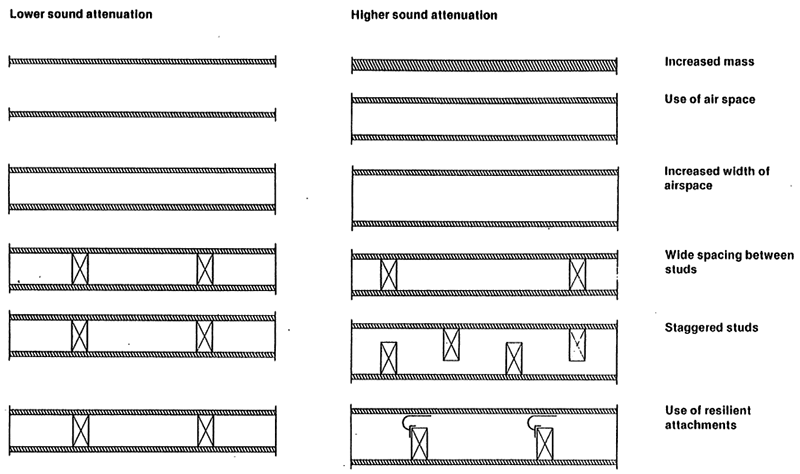
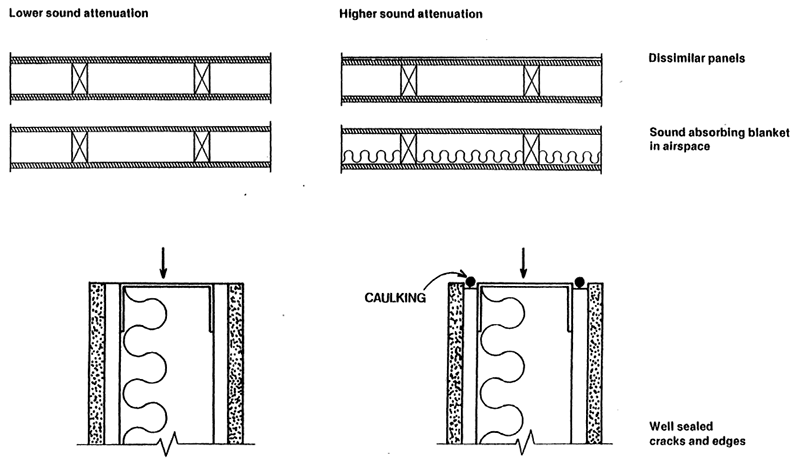
Figure 4.13 shows a sample of wall types ranging from the lowest to the highest sound insulation values. The cost of these walls in dollars per square foot is given for comparison of cost effectiveness.12
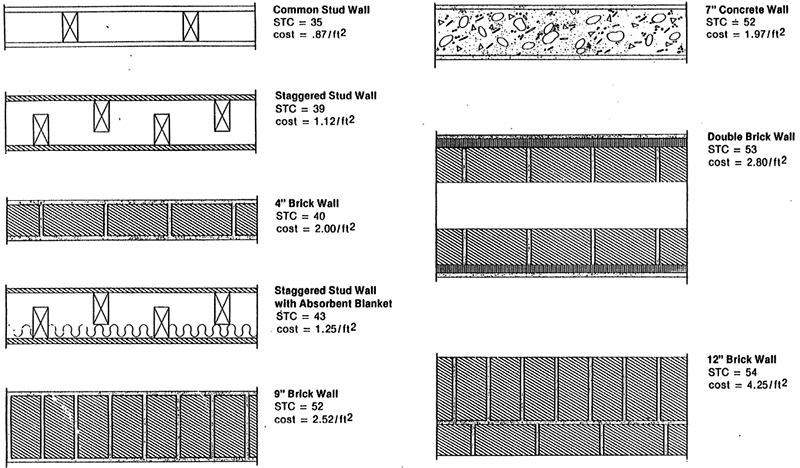
B) Windows
Sound enters a building through its acoustically weakest points, and windows are one of the weakest parts of a wall. An open or weak window will severely negate the effect of a very strong wall. Whenever windows are going to be a part of the building design, they should be given acoustical consideration. Figure 4.14 illustrates the effects of windows on the sound transmission of walls. For example, if a wall with an STC rating of 45 contains a window with an STC rating of 26 covering only 20% of its area, the overall STC of the composite partition will be 33, a reduction of 12 dB.
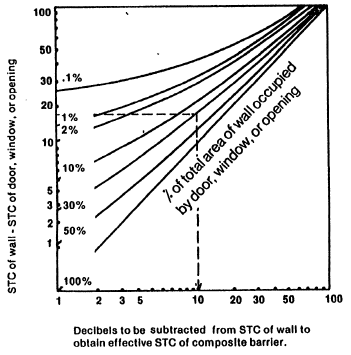
The following is a discussion of techniques that can be used to reduce noise in a building by means of its windows. These techniques range from a blocking of the principal paths of noise entry to a blocking of the most indirect paths.
In general, the airspace between the panes should not be less than 2-4 inches if an STC above 40 is desired. If this is not possible, a heavy single-glazed window can be used. The use of slightly non-parallel panes is a technique employed when extremely high sound insulation is required, such as in control rooms of television studios.
The thickness of double-glazed panes may vary from 1 /8 to 1 /4 inch or more per pane. Although thickness is important, the factors which most determine the noise resistance of the window is the use of sealant and the width of the airspace.
As in the case of all windows, proper sealing is extremely important. To achieve an STC above 43, double-glazed windows should be sealed permanently. If the windows must be openable, there are available special frames and sealers for openable windows which allow a maximum STC of 43.15
Permanently sealed double-glazed windows often require an air pressure control system to maintain a constant air pressure and minimal moisture in the airspace. Without this system, the panes may deflect, and, in extremely severe cases, pop out of the frames.
To further insure isolation of noise between double-glazed panes, the panes could be of different thicknesses, different weights, and slightly non-parallel to each other. This prevents acoustical coupling and resonance of sound waves.
C) Doors
Acoustically, doors are even weaker than windows, and more difficult to treat. Any door will reduce the insulation value of the surrounding wall. The common, hollow core door has an STC rating of 17 dB. Taking up about 20% of the wall, this door will reduce a 48 STC wall to 24 STC. To strengthen a door against noise, the hollow core door can be replaced by a heavier solid core door that is well sealed16 and is relatively inexpensive. A solid core door with vinyl seal around the edges and carpeting on the floor will reduce the same 48 STC wall to only 33dB.17 An increased sound insulation value can be achieved if gasketed stops or drop bar threshold closers are installed at the bottom edge of the door. (See Figure 4.15)
The alternative solution to doors is to eliminate them whenever possible from the severely impacted walls and place them in more shielded walls.
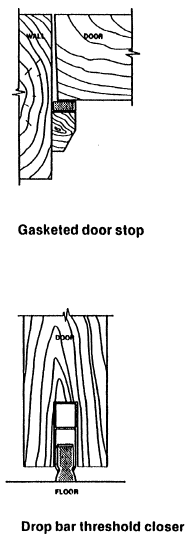
D) Ceilings
Acoustical treatment of ceilings is not usually necessary unless the noise is extremely severe or the noise source is passing over the building. The ordinary plaster ceiling should provide adequate sound insulation except in extremely severe cases. An acoustically weak ceiling which is likely to require treatment is the beamed ceiling.18 Beamed ceilings may be modified by the addition of a layer of fiberglass or some other noise resistant material. Suspended ceilings are the most effective noise reducers but they are also the most expensive.
E) Floors
In the case of highway noise, floors would only require acoustical treatment if the highway were passing under the building. In this case, flooring would have to provide protection against structural vibrations as well as airborne sound.
Two ways to insulate a floor from noise are to install a solid concrete slab at least 6 inches thick or install a floating floor. In general, the floating floor gives the greatest amount of sound and vibration insulation; however, it is extremely expensive. Basically, a floating floor consists of a wood or concrete slab placed over the structural slab, but separated by a resilient material. The resilient material isolates the surface slab from the structural slab and the surrounding walls.
F) Interior Design
Overall interior noise levels can be reduced by the extensive use of thick, heavy carpeting, drapes, wall hangings, and acoustical ceiling tiles. These materials absorb sound. They cannot prevent noise from coming through the walls, but they can reduce overall sound levels by reducing sound reverberations.
G) Masking
Another way of coping with noise is to drown it out with background noise. This technique is known as masking. It can be very effective in reducing noise fluctuations which are often the most annoying aspects of noise. Masking can be produced by air conditioning and heating systems, soft music, or electronic devices.
A noise barrier is an obstacle placed between a noise source and a receiver which interrupts the path of the noise. They can be made out of many different substances:
The choice of a particular alternative depends upon considerations of space, cost, safety and aesthetics, as well as the desired level of sound reduction. The effectiveness of the barrier is dependent on the mass and height of the barrier, and its distance from the noise source and the receiver. To be effective a barrier must block the “line of sight” between the highest point of a noise source, such as a truck’s exhaust stack, and the highest part of the receiver. This is illustrated in Figure 4.16.

To be most effective, a barrier must be long and continuous to prevent sounds from passing around the ends. It must also be solid, with few, if any, holes, cracks or openings. It must also be strong and flexible enough to withstand wind pressure.
Safety is another important consideration in barrier construction. These may include such requirements as slope, the distance from the roadway, the use of a guard rail, and discontinuation of barriers at intersections.
Aesthetic design is also important. A barrier constructed without regard for aesthetic considerations could easily be an eyesore. A well-designed berm or fence can aesthetically improve an area from viewpoints of both the motorist and the users of nearby land.
A) Earth Berms
An earth berm, a long mound of earth running parallel to the highway, is one of the most frequently used barriers. Figure 4.17 shows a cross-section of a berm.

Berms can range from five to fifty feet in height. The higher the berm, the more land is required for its construction. Because of the amount of land required, a berm is not always the most practical solution to highway noise. Different techniques must be applied in urban as distinct from rural settings.
A berm can provide noise attenuation of up to 15 dBA if it is several feet higher than the “line of sight” between the noise source and the receiver. This is comparable to the noise reduction of various walls and fences which are used as barriers. However, earth berms possess an added advantage: instead of reflecting noise from one side of the highway to another, as walls do,19 and thus increasing the noise heard on the opposite side, they deflect sound upwards. Figure 4.18 illustrates this phenomenon.

The cost of building a berm varies with the area of the country and the nature of the project. In California, the statewide average for building a berm is about $1 per cubic yard when the earth is at the site.20
In planning a berm, one must include seeding and planting in figuring cost. Also to be included are land costs and maintenance in relation to erosion, drainage, snowplowing, mowing, and perhaps future seeding. It costs approximately $1,000 per acre per year to maintain a berm which is accessible to maintenance equipment.21
B) Walls and Fences as Barriers
In addition to the more usual function of keeping people, animals and vehicles from entering the highway right of way at undesired locations, a properly designed fence or wall can also provide visual and acoustical separation between highway noise sources and adjacent land areas. This method can reduce noise as much as 15 dBA.22
The vertical construction and minimal width of walls and fences makes installation possible when space is severely limited. This is especially important when land costs are high, and where buildings are already adjacent to the highway. The advantages and disadvantages of wall and fence barriers are summarized in Figure 4.19.
The number of design variations for fence and wall barriers is virtually unlimited.
Acoustically, any solid continuous structure will suffice, provided that it is high enough, and provided that the barrier is of adequate mass and density.
The cost of a fence or wall type barrier can vary considerably according to the type of construction, the material used, local availability of materials and skills, and the barrier’s dimensions. Not all types of barriers are suited for all climates, and local conditions may cause significant differences in the maintenance cost of the various barrier types. The cost questions must be evaluated on a local basis.
Some of the frequently used materials for fence and wall construction are masonry, precast concrete, and wood.
Masonry noise barriers can be made of concrete blocks, brick or stone. A concrete block barrier might range in cost from $10 a linear foot for a 6-ft. high wall, to $75 a linear foot for a 12-ft. high wall. This latter figure includes a safety railing. In general, a concrete block wall would cost $50 to $60 a linear foot.23 To alleviate the monotony of a long run of wall, pilasters can be used: a 20 ft. high concrete wall with pilasters might cost $300 per linear foot.24 Brick and stone are extremely expensive and should only be used for special aesthetic considerations.25
Precast concrete panels offer opportunities for cost reduction. A 13' 4" high wall in Fairfield, California constructed of precast concrete panels cost only $29.50 per linear foot Wood noise barriers are another possibility. They tend to be less expensive than other methods but are not as durable. An estimated cost for a 6' high 5/8" plywood fence is $5.00 per linear foot.26
C) Plantings
Plants absorb and scatter sound waves. However, the effectiveness of trees, shrubs, and other plantings as noise reducers is the subject of some debate. Some conclusions can, however, be drawn:
In general, plantings by themselves do not provide much sound attenuation. It is more effective, therefore, to use plantings in conjunction with other noise reduction techniques and for aesthetic enhancement.
The cost of plantings varies with the species selected, the section of the country, the climate, and the width of the buffer strip. For deciduous trees and evergreens, costs range from $10 to $50 a linear foot. The width of such a strip would be approximately 40 feet for deciduous trees and 20 feet for evergreens. Planting shrubs between the trees so as to form a dense ground cover would double the price.
D) Combinations of Various Barrier Designs
Often, the most economical, acoustically acceptable, and aesthetically pleasing barrier is some combination of the barrier types previously discussed.
For example, the Milwaukee County Expressway and Transportation Commission feels that barriers constructed of precast concrete on top of an earth berm provide maximum benefit for the cost.27 They estimate that such a combination costs $51 per linear foot.
In addition to cost advantages, an earth berm with a barrier wall on top of it possesses several other advantages over both a wall or a berm alone: 1) it is more visually pleasing than a wall of equivalent height; 2) the berm portion of this combination is less dangerous for a motorist leaving the roadway; 3) the non-vertical construction of the berm does not reflect noise back to the opposite side of the highway the way a wall does; 4) the combination requires less land than would be required for a berm of equivalent height and slope; and 5) the wall provides a fencing function not provided by a berm.
Another combination to be considered is that of plantings in combination with a barrier. Not only do plantings and ground cover provide some additional noise attenuation, but they also increase visual appeal.
Figure 4.19 provides a summary of the physical techniques which can be used by designers, builders, and developers to reduce highway noise impacts. Some conclusions follow which may be useful in getting them implemented.
| Physical Technique | Potential Effectiveness | Situations Where Most Effective | Cost | Relevant Administrative Technique | Comments |
|---|---|---|---|---|---|
| Acoustical Site Planning | Good-excellent: depends on size of lot and natural terrain. | Before building construction, before subdivision development | Low. only costs are fees of acoustical consultant and site planner. | Building code* Health code |
Fairly inexpensive but requires space which may be unavailable. Has limited sound reduction. Positive aesthetic impacts. |
| Acoustical Architectural Design | Fair | Before building construction. | Low: only cost is that of acoustical consultant | Building code* Health code |
Low cost but limited effectiveness. |
| Acoustical construction. | Excellent for interior, poor for exterior. | During building construction best. Most costly after construction. | Varies with amount of noise reduction desired but generally high especially after construction. | Building code* Health code |
Most effective noise reduction for interiors |
| Barriers | Fair-excellent, depends on height and mass | Varies with type of barrier | Moderate-high: varies with type of barrier, see below. | Zoning, subdivision rules, health code | High noise reduction and potentially low cost. Achieves exterior noise reduction. Can have adverse aesthetic impacts. |
| Earth Berms | Good-excellent | Best during road construction when earth is available. Costly after road construction. Impractical in densely populated areas where land is scarce. | Moderate-high: depends on availability of earth. | Good noise reduction properties and aesthetic appeal, but requires space and requires maintenance. | |
| Walls and Fences | Poor-excellent, depends on height and mass | Any time | Low-high: depends on height and thickness. | Requires little space and no maintenance, but may be aesthetically unappealing and can reflect noise to other side of road. | |
| Plantings | Poor | After road construction. After building construction. | Moderate high: depends on size of buffer strip. | Poor noise reduction but often necessary for aesthetic appeal. Best used in combination with other techniques. | |
| Combinations | Good-excellent. | Depends on particular combination. | Moderate-high: depends on type of barrier used | Potentially high noise reduction and aesthetic appeal. |
*Administrative techniques which can achieve any physical technique are health codes, occupancy permit procedures, architectural review boards, and municipal design services.
As is indicated by the chart below, five factors which must be considered in the selection of noise reduction measures include the following:
Noise Reduction: The physical techniques discussed vary in their noise reduction capabilities. For example, the effectiveness of the less expensive techniques, such as site planning and acoustical architectural design, is limited to situations where there is some distance between the buildings and the noise source. If the noise source is nearby and significant noise reduction is desired regardless of the expense, then more expensive measures, such as acoustical soundproofing and barrier construction, may be necessary.
Situation where a technique is most applicable: The applicability of a technique is determined by the population density of an area and the point in the development process at which the technique is to be used, i.e., its timing. In a densely populated area, site planning (perhaps in conjunction with construction of a berm and a region of plantings) can often solve the noise problem. In a high-density area where land is scarce and expensive, a better alternative would be barrier construction and acoustical soundproofing of the buildings.
The timing of a technique also determines whether or not it is applicable. There are three points at which physical noise reduction measures can be used: in the planning phase; during building construction; and after construction. Techniques applicable during the planning phase Include acoustical site planning and acoustical architectural design. During the construction phase, those techniques most applicable for highways are berms and barriers, since building materials are available at the site; and during building construction the most appropriate measure is acoustical soundproofing. It is possible to undertake noise reduction measures after construction, but costs are much higher.
Cost: Cost is a very important consideration in the selection of a physical noise reduction technique. Generally, cost is determined by the amount of noise reduction desired and whether the noise measure is a preventative or ameliorative one.
The most effective noise reduction measures are often the most expensive. These include barrier construction and acoustical soundproofing. However, if action is taken as a preventative measure in the planning stage, there is often no need for the more expensive techniques.
Relevant administrative techniques: All these physical techniques depend upon administrative actions for implementation. It is possible that physical measures to reduce noise would be taken without local government action, but since they involve extra expense, it is unlikely that they would be adopted on any significant scale. Many administrative means exist to achieve each physical noise reduction technique. For example, a noise impacted area can be zoned to specify details of development design or construction. In such an area, buffer strips (acoustical site planning), acoustical arrangement of living spaces (acoustical architectural design), building insulation (acoustical construction techniques), and barrier construction could be required. Similar requirements could be included in the subdivision laws. Building and health codes, enforced by withholding an occupancy permit, are effective ways to bring about acoustical soundproofing. As explained in the section on Building Codes, particular acoustical construction materials can be required or specific performance standards established.
Aesthetics: Aesthetic and quality of life considerations are another important area of concern. They depend largely on local preferences and climate, and opinions of what is aesthetically pleasing will vary among communities.
Whatever the aesthetic judgement, aesthetic considerations must be incorporated into the planning and construction process to ensure that the solution which results is not offensive to the community. This can save a great deal of time and money in the long run.
Finally, it should be stressed that no single technique or combination of techniques is best for all situations, and that technique which is best will depend on the nature of the project. The factors which are discussed above (i.e., noise reduction, cost, applicability, and aesthetics) must be balanced against each other to determine which technique or combination of techniques will be most effective in a given situation.
1 Hans Bernard Reichow, “Town Planning and Noise Abatement,” Architect’s Journal, 137-7 (February 13, 1963) pp. 357-360.
2 “Live-in Wall, 3,900 Feet Long, is Also a Sound Shield,” Engineering Record, (September 6, 1973).
3 “Live-ln Wall is Also Sound Shield,” Engineering News-Record, September 6, 1973.
4 “Live-in Wall…”
5 This technique is used extensively in Cerritos, California.
6 R.K. Cook and P. Chrzanowski, “Transmission of Noise Through Walls and Floors,” Cyril Harris, ed., Handbook of Noise Control, McGraw-Hill Book Company, Inc. (New York, 1957).
7 Leslie T. Doelle, Environmental Acoustics, (New York, McGraw-Hill Book Company, 1972), pp. 232-233.
8 Ibid, p. 172.
9 Ibid, p. 162.
10 Doelle, p. 20.
11 United States Gypsum, Sound Control Construction: Principles and Performance (Chicago, 1972), p. 66.
12 Costs taken from National Construction Estimator, 1970-1, 18th Edition, Craftsman Book Company (Los Angeles, 1970).
13 U.S. Department of Housing and Urban Development, A study of Techniques to Increase the Sound Insulation of Building Elements, Report No. WR 73-5, Washington, D.C., June 1973.
14 Los Angeles Department of Airports, Guide to the Soundproofing of Existing Homes Against Exterior Noise, Report No. WCR 70-2, March 1970, pp. 9-11, 22-30. In this report, the function and performance of a number of operable seals are described.
15 Ibid.
16 D.E. Bishop and P.W. Hirtie, “Notes on the Sound Transmission Loss of Residential-Type Windows and Doors,” Journal of the Acoustical Society of America, 43:4 (1968).
17 U.S. Gypsum, Sound Control…, p.100.
18 Ibid., p. 15.
19 Reflection of noise from one side of the highway to another can increase sound levels by 3 dBA. Scholes, Salvidge, and Sargent, “Barriers and Traffic Noise Peaks,” Applied Acoustics, 5:3 (July 1972) p. 217.
20 This estimate was provided by the California Highway Department.
21 Ibid.
22 California Division of Highways, Highway Noise Control, A Value Engineering Study, (October 1972).
23 Figure provided by an official of the California Highway Department.
24 Representative cost estimates of materials and labor of construction but excluding real estate acquisition; private
25 California Division of Highways, Highway Noise Control, Value Engineering Study, (October 1972), p. 33.
26 California Division of Highways, Highway Noise Control, Value Engineering Study, (October 1972), p. 46.
27 Milwaukee County Expressway and Transportation Commission, Noise Impact Study of the Airport Spur Vol. II: Technical Report, (March 1973), pp. 7-21.